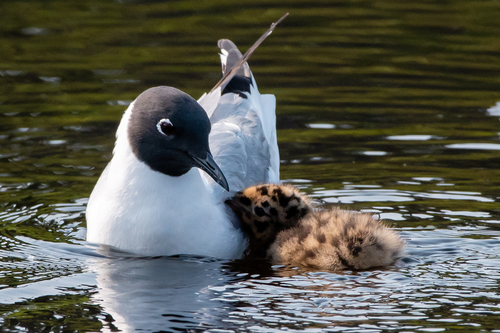
Bonaparte's Gull
Bonaparte's Gull (*Chroicocephalus philadelphia*) is a small, elegant gull known for its distinctive black head during the breeding season and its buoyant, tern-like flight. Unlike many gulls, it often nests in trees and forages in a variety of habitats, from coastal waters to inland lakes and marshes. It plays an important ecological role as both predator and prey, consuming small fish and invertebrates, and in turn being a food source for larger predators. It holds no particular cultural significance other than being a favorite among birdwatchers for its graceful appearance and active behavior.
28-38 cm
Length
76-84 cm
Wingspan
Least Concern
Conservation Status
Distribution
Breeds primarily in boreal forests of Canada and Alaska. Winters along the coasts of North America, from southern Alaska and Nova Scotia south to Mexico and the Caribbean. Also occurs in the Great Lakes region.
Lifespan
Up to 12 years recorded in the wild, but typically shorter.
Bonaparte's Gull's Habitat
Habitat Types
Boreal forests, Coastal waters, Estuaries, Inland lakes, Marshes, Rivers
Climate Zones
Subarctic, Temperate, Subtropical (in winter)
Adaptations
Their relatively small size and agility allow them to forage effectively in a variety of habitats, including dense forests and open water. Their webbed feet are adapted for swimming and perching.
Variations
No recognized subspecies.
Appearance
Breeding Plumage
Breeding adults have a black head, white body, and gray wings with black-tipped primaries. Non-breeding adults have a white head with a dark spot behind the eye.
Seasonal Feather Changes
The black head is only present during the breeding season (spring and summer).
Sex Based Plumage Differences
Minimal; males and females have similar plumage.
Notable Features
Black head during breeding season, Slender, black bill, Red-orange legs, White wedge on outer primaries (visible in flight)
Diet and Feeding
Primary Foods
Small fish, Aquatic invertebrates, Insects, Crustaceans
Foraging Behavior
Forages by dipping, surface-seizing, and aerial hawking. Often hovers and dives for prey, similar to terns. May also forage on the ground or in shallow water.
Specializations
Agile flight allows for efficient capture of insects in the air.
Seasonal Diet Variations
Diet shifts with prey availability. During breeding season, may rely more on insects. In winter, diet is more heavily focused on fish and marine invertebrates.
Behavior
Social Structure
Gregarious, often found in flocks, especially during migration and winter. Forms loose breeding colonies.
Communication
Variety of calls, including a nasal 'kerr' or 'kree', Visual displays, such as head-bobbing and wing-lifting
Migration
Long-distance migrant. Travels between breeding grounds in boreal forests and coastal wintering areas. Migrates in flocks, often following coastlines or rivers.
Territorial or Group Behaviors
Defends a small territory around the nest during breeding season. Otherwise, generally non-territorial.
Conservation
Threats
Habitat loss (deforestation in breeding areas), Climate change (affecting prey availability and breeding habitat), Pollution (contaminants in aquatic ecosystems), Disturbance at breeding colonies
Protection Programs
Protected under the Migratory Bird Treaty Act in the US and Canada, Monitoring programs to track population trends
Local National Laws
Migratory Bird Treaty Act (US and Canada)
Population Trend
Stable
Population Estimates
Global population estimated at 250,000 - 1,100,000 individuals.
Interesting Facts
Named after a zoologist, not the emperor
The species is named after Charles Lucien Bonaparte, a nephew of Napoleon and a prominent ornithologist.
One of the few tree-nesting gulls
Most gulls nest on the ground, but Bonaparte's Gull typically nests in conifer trees.
Known for their Tern-like flight
More buoyant and agile in flight compared to other gulls of similar size.
Faqs about Bonaparte's Gull
What is the difference between a Bonaparte's Gull and a Laughing Gull?
Bonaparte's Gulls are smaller, have a black bill (Laughing Gulls have a reddish bill), and have a different pattern of black and white on their wingtips. In breeding plumage, both have black heads, but in non-breeding plumage, Bonaparte's Gulls have a distinctive dark spot behind the eye.
Where can I see Bonaparte's Gulls?
Look for them along coastlines, estuaries, and large inland lakes during migration and winter. During the breeding season, they are found in boreal forests of Canada and Alaska.
Do Bonaparte's Gulls eat garbage?
While they are opportunistic feeders, they primarily eat small fish and invertebrates, and are less likely to scavenge at landfills than larger gull species.
Copyright @ Nature Style Limited. All Rights Reserved.
 English
English